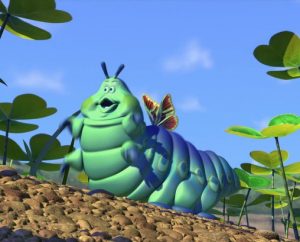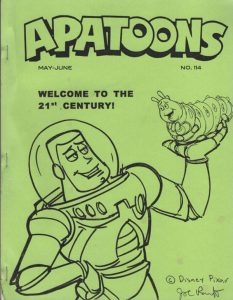Born in Pasadena, California (but raised in Whittier, California) on March 13, 1960, Joe Ranft studied character animation at California Institute of the Arts. His student film caught the attention of Disney, where he was hired and began working in 1980 for several years on a variety of television projects that never got made.
He received additional training from Disney Legend Eric Larson, as well as getting some improvisational theater training from a Los Angeles improvisation group called The Groundlings. He did some story work on The Lion King and Beauty and the Beast.
Ranft had known John Lasseter at CalArts in the 1970s and ended up joining Pixar in 1992. His first work included pitching and storyboarding the Green Army Men sequence for Toy Story (1995). He worked on story development for all the Pixar feature films, including some work on Cars (2006) which he was co-directing when he passed away in 2005.
Because of his performing background, he provided voices for some of the characters in the Pixar films: Lenny the Binoculars (Toy Story), Heimlich the Caterpillar (A Bug’s Life), Wheezy the Penguin (Toy Story 2), various incidental voices (Monsters, Inc.), Jacques the Shrimp (Finding Nemo), various incidental voices (The Incredibles) and Red and a Peterbilt (Cars).
On April 23, 1999, Joe was out on vacation with his family to Florida. He dropped by Disney Feature Animation Florida and the Disney Institute where I was an animation instructor and I got a chance to talk with him.
Jim Korkis: What are some hints you can share with us about storyboarding?
Joe Ranft: Storyboarding is really re-boarding. Your first idea is never good enough and you have to keep changing. In the two-and-half years we worked on A Bug’s Life, we ended up with over 27,500 storyboard drawings we eventually used but tossed out tons of others.
A good storyboard panel tells just one thing and is staged to tell just that one thing. How can you check? You put it on the board and walk away from it with your back toward it and then spin around quickly and look at it and see if it clearly tells what you want it to tell. And if you feel that you are lying to yourself, you bring someone else to look at it.
A good storyman has to juggle so many things like acting, staging, and composition …all in one panel!
Jim Korkis: How is it pitching a storyboard to John Lasseter?
Joe Ranft: When you pitch, you might get John’s attention for maybe twenty minutes before he is reeling off suggestions like “let’s make that wider,” “do that from a different angle,” and we are scrambling to take these quick notes on Post-It Notes and put it on the board.
We have a storyboard reel with a caricature of John Lasseter wearing a purple sweatshirt instead of his Hawaiian shirt. That is the truth. For story meetings, John will wear a purple sweatshirt. And early in the morning, his hair isn’t quite combed (laughs).
Jim Korkis: You seem to use John Ratzenberg a lot.
Joe Ranft: John Ratzenberg, who did the voice of P.T. Flea, is so wonderful that you can just send him a script and a tape and he could send you back a terrific performance. In the booth, after he did the lines as they were in the script, he’d say, “Let me give you it this way” and did some marvelous things.
In the flea circus scene where he goes right to camera and says “in just 15 seconds” was something he added and we went back and adjusted our boards. And his line where he introduces himself was his improv and he said it came from an old radio show.
Jim Korkis: You’re pretty modest but you’ve done some great voice work, as well, like Hemlich in A Bug’s Life.
Joe Ranft: I think I got Hemlich because of John Lasseter’s wife. She laughed when I did the lines on the scratch track but didn’t when they brought in this professional actor to do them. My son, Joe, did a kid ant voice in A Bug’s Life. Doing all these voices, I had to join the Screen Actors Guild.
Jim Korkis: I know you sometimes do “incidental voices” as well. Did you do any on A Bug’s Life?
Joe Ranft: I did some incidental voices like the flies that say “Burn him again” and “I’ve only got 24 hours to live and I’m not spending it here.”
Jim Korkis: Do you do those voices for your kids, as well?
Joe Ranft: I read stories to my kids and I do the funny voices and sometimes they tell me to stop doing the voices and just read the story.
Jim Korkis: Do you script the outtakes that appear at the end of the film for the voice actors?
Joe Ranft: The outtakes are done on the last day of voice recording for each actor if time permitted. They were not boarded but quick sketch suggestions were done of some of them. Some of them obviously were for adults so we purposely tried to include some slapstick bits for the kids. Those are my favorites.
Jim Korkis: I understand the story began in a different direction for A Bug’s Life.
 Joe Ranft: Originally, the story of A Bug’s Life was supposed to be about a red ant named “Red” who ran the circus instead of P.T. Flea, but they hit a stonewall in terms of developing the story.
Joe Ranft: Originally, the story of A Bug’s Life was supposed to be about a red ant named “Red” who ran the circus instead of P.T. Flea, but they hit a stonewall in terms of developing the story.
We get asked if the film was influenced by The Magnificent Seven (1960), and all I can say is that all the guys at Pixar are big film buffs, and I also see some elements from The Three Amigos (1986), but that story falls apart for me when they are discovered not to be gunfighters. We solved that problem by coming up with the bird device storyline after the revelation. Of course, the original inspiration was the story of The Grasshopper and the Ants that Disney did as far back as 1934.
Jim Korkis: Anything you remember getting cut from the film after it was in production?
Joe Ranft: On the original boards, the circus bugs were doing all sorts of things offstage that eventually got cut because the scene was so long. For instance, the spider is practicing weaving the safety web within 15 seconds while Dim times her and it is a terrible mess. “Are you sure it was 15 seconds?” “Let me check.” “You have to check whether it was 15 seconds?”
The praying mantis was much harsher in ignoring his wife, Gypsy. “Haven’t you forgotten half your act?” she asks, extending her hand to be kissed. He replies, “You are right” and he comes back and grabs his turban to put on his head.
In the arena, when Heimlich sees the kid flies with the candy corn and offers to help them finish it, the line on the storyboard was “Get out of here, Fatso” which was cut from the film.
Jim Korkis: Thank you so much, Joe, for sharing your time.
Sadly, on August 16th, 2005, Joe was killed when his car crashed through a guard rail and plunged into the Pacific Ocean in Mendocino County, California. He died during the production of Cars, which he co-directed. His contributions to Disney and Pixar were vital – and he will never be forgotten. His colleague John Musker posted this tribute in 2010:





 Jim Korkis is an internationally respected animation historian who in recent years has devoted his attention to the many worlds of Disney. He was a columnist for a variety of animation magazines. With his former writing partner, John Cawley, he authored several animation related books including The Encyclopedia of Cartoon Superstars, How to Create Animation, Cartoon Confidential and Get Animated’s Animation Art Buyer’s Guide. He taught animation classes at the Disney Institute in Florida as well as instructing classes on acting and animation history for Disney Feature Animation: Florida.
Jim Korkis is an internationally respected animation historian who in recent years has devoted his attention to the many worlds of Disney. He was a columnist for a variety of animation magazines. With his former writing partner, John Cawley, he authored several animation related books including The Encyclopedia of Cartoon Superstars, How to Create Animation, Cartoon Confidential and Get Animated’s Animation Art Buyer’s Guide. He taught animation classes at the Disney Institute in Florida as well as instructing classes on acting and animation history for Disney Feature Animation: Florida.




















































Joe and I were the cartoon storyboard guys in the Amblin’ trailers for Who Framed Roger Rabbit? I always admired Joe’s extremely relaxed attitude toward story, changes just never bothered him. My problem boarding was that if I put a lot of effort in to drawing a sequence and it got tossed, I tended to take it personally. That’s very wearing on your disposition. Joe could take anything. Peter Seaman and Jeff Price were the script writers and didn’t like it when Joe or I would come up with a line for the characters to say. Bob Zemeckis would quite often like our suggestions and would say “Put it in the script!” It got so that Seaman and Price didn’t want to talk to us anymore. Those were special days, the best experience I ever had storyboarding, even though the Marvin Acme funeral sequence got cut. I was very shocked and saddened by Joe’s untimely accidental death, he was absolutely unique, a “childult” in every way.